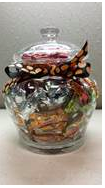Our school had a candy guessing contest for Hallowe’en. There were three Jars of Unusual Shape, and various sizes.
The spirit of Francis Galton demanded that I look at the data. Candy guessing, like measuring temperature, is a classic case where averaging multiple readings from different sensors is expected to do very well. Was the crowd wise? Yes.
- The unweighted average beat:
- 67% of guessers on Jar 1
- 78% of guessers on Jar 2
- 97% of guessers on Jar 3, and
- 97% of guessers overall
- The median beat:
- 89% of guessers on Jar 1
- 83% of guessers on Jar 2
- 78% of guessers on Jar 3, and
- 97% of guessers overall
Only one person beat the unweighted average, and two others were close. There were 36 people who guessed all three jars (and one anonymous blogger who guessed only one jar and was excluded from the analysis). The top guesser had an overall error of 9%, while the unweighted average had an overall error of 11%. Two other guessers came close, with an average error of 12%. The worst guessers had overall error rates greater than 100%, with the worst being 193% too high.
The unweighted average was never the best on a single jar — though on Jar 3 it was only off by 1. (The guesser on Jar 3 was exactly correct.)
The measure I used was the overall Average Absolute %Error. The individual rankings change slightly If instead we use Absolute Average %Error, but the main result holds.



